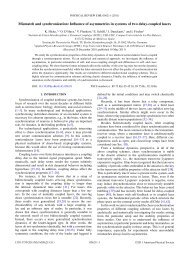DBI Analysis of Open String Bound States on Non-compact D-branes
DBI Analysis of Open String Bound States on Non-compact D-branes
DBI Analysis of Open String Bound States on Non-compact D-branes
Create successful ePaper yourself
Turn your PDF publications into a flip-book with our unique Google optimized e-Paper software.
CHAPTER 3. SUPERSTRINGS 52associated with the unc<strong>on</strong>strained theory using the GSO projecti<strong>on</strong>, and <strong>on</strong> the twoType II theories resulting from the closed string spectra. The main purpose <str<strong>on</strong>g>of</str<strong>on</strong>g> thischapter was to obtain the massless fields c<strong>on</strong>tained in the Type II theories, given thatthese are the <strong>on</strong>es that interest us in the remainder <str<strong>on</strong>g>of</str<strong>on</strong>g> this writing, and getting there asfast as possible without being too sloppy. We saw that in the end we obtained spacetimebos<strong>on</strong>s and fermi<strong>on</strong>s, and that their numbers agree at every mass level which is agood indicati<strong>on</strong> that space-time preserves supersymmetry. We also saw that both TypeII theories c<strong>on</strong>tain the (more or less) same g µν , B µν and Φ fields we already encounteredearlier in bos<strong>on</strong>ic string theory. The Ram<strong>on</strong>d-Ram<strong>on</strong>d fields both theories spawned werequite different though, being <strong>on</strong>e- and three-form gauge fields for the Type IIA theory,and zero-, two- and self-dual four-form gauge fields for the Type IIB theory.We omitted a lot <str<strong>on</strong>g>of</str<strong>on</strong>g> the technical subtleties <str<strong>on</strong>g>of</str<strong>on</strong>g> superstring theory. In particular, wedid not go deeply into supersymmetry, and completely disregarded the super-Virasoroalgebra, spawned by the modes <str<strong>on</strong>g>of</str<strong>on</strong>g> the energy-momentum tensor and supercurrent expansi<strong>on</strong>s.Readers dissatisfied and/or annoyed by such a lack <str<strong>on</strong>g>of</str<strong>on</strong>g> detail and rigour areurged to c<strong>on</strong>sult the given reference works cited in the introductory chapter to remedythis ailment. Complementing these, a good number <str<strong>on</strong>g>of</str<strong>on</strong>g> equally good review papers arewidely available <strong>on</strong> the internet, some <str<strong>on</strong>g>of</str<strong>on</strong>g> which are also listed in the bibliography.
















